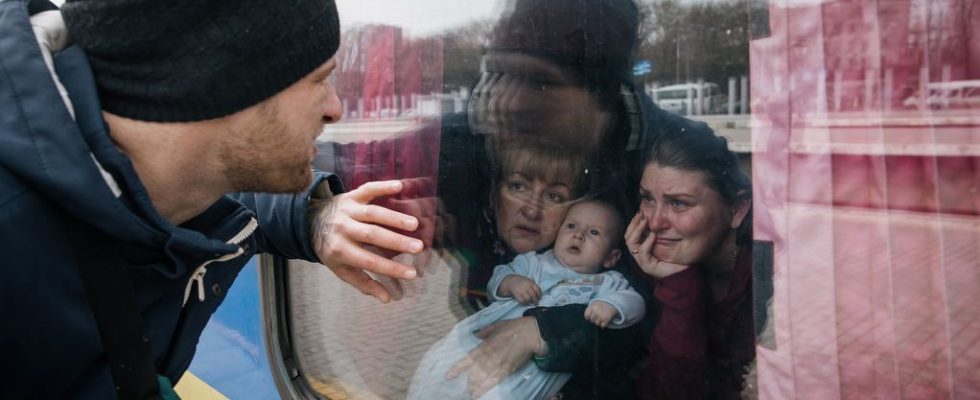“International attention risks turning away from Ukraine, and this will have consequences,” warned Ukrainian President Volodymyr Zelensky because of the “tragedy” hitting Israel following Hamas attacks, during a interview on the France 2 television channel broadcast Tuesday evening.
On February 24, 2022, Vladimir Putin’s Russia attacked Ukraine and war photographers went there to cover the conflict. And this work continues today. Laurence Geai and other of his colleagues from the agency MYOP are part of. Their photos taken on site are collected in a book entitled Ukraine, Fragments. The journalist explains to 20 minutes the making of a photo taken in the Odessa train station, March 3, 2022. She also looks back on her job as a war photographer in light of her experience in the Near East and the Middle East.
What do we see in the image?
“It’s a photo which represents a family, the husband is on the left of the image and he observes his family on the train, at the very beginning of the war in Ukraine on a platform at the Odessa station,” explains Laurence Jay 20 minutes. “It’s a heartbreaking goodbye because they’re in tears, he’s trying to touch them one last time through the glass. It was very sad, very moving, I also had tears in my eyes behind my camera.” The photographer adds: “I played on the reflection of the window so that we have the whole scene and see all the emotions.” She concludes: “It’s a photo where everyone can identify. » After the general mobilization decreed by President Volodymyr Zelensky, Ukrainian men between the ages of 18 and 60 are prohibited from leaving the country. Women and children flee to the west of the country or abroad.
What is the shooting context?
“I had just arrived in Ukraine… In general, when there is an attack, there are often people fleeing the country, so I went to the station, after noticing that an evacuation train was going leave,” explains the photographer to 20 minutes. “I saw this man who touched me a lot and I waited, I didn’t take photos right away, then I asked for permission to participate in this farewell moment while being very discreet and they acquiesced. At that time, I didn’t have a translator with me but we understood each other by looking at each other. Sometimes there’s no need to argue. When people don’t want to be photographed, you know it right away. »
On her job as a photojournalist, she confides: “My goal is to take a photo that will be remembered to tell a story, with everything I saw in the image. » She adds: “I have to take a photo that matches the emotion that everyone felt, by making the information accessible. » She explains that she uses fixed focal lengths (24 mm or 35 mm) because she considers that it is up to her to move and be close to “have intimate photos”, specifying that “this is done by candy “. She says she only uses a zoom lens, like the 24-70 mm lens, on the front line when “it’s tense”.
The extra anecdote
Laurence Geai has worked in several war zones around the world and acquired extensive experience in photography in conflict zones. In addition to Ukraine, she has been to Syria and Iraq. The journalist tells us that she had to overcome her shyness at the start of her career because “it’s a job where you have to dare” and “go through the window when the door is closed”. “The war zone is a special terrain. You need to have some knowledge of the people, the fighters and the culture of the country. The front, the zero line, is more dangerous than the rear line… but at the rear there are risks of bombings, shells, artillery, and you have to have the right reflexes while listening to advice fighters. » The photographer adds that there is training but that nothing replaces “the field”. “Every field is different. In Mosul, Iraq, I’m not going to put the press loop on my bulletproof vest because I know that ISIS would be very happy to target a journalist. On the other hand, in Israel, I will highlight it. »
When asked about the danger, she responds: “It transforms us, we are afraid, we tremble, so we have to concentrate on the framing of the photo, talking to ourselves. » Concerning the management of the sight of death, she confides: “It is easier on people who have already died than on those who are dying. » The journalist explains to us that she was very touched by the images of people fleeing the “rave party” in Israel or those of the victims of the bombings in Gaza, where she has “a lot of contact on site”. She adds: “It’s more difficult for me to observe it from afar than to be there to tell it, because I feel useful when I’m on the ground. But it’s very hard, I won’t hide it from you, because I’m very sensitive. » But she admits: “There, I really want to go to Israel. »

